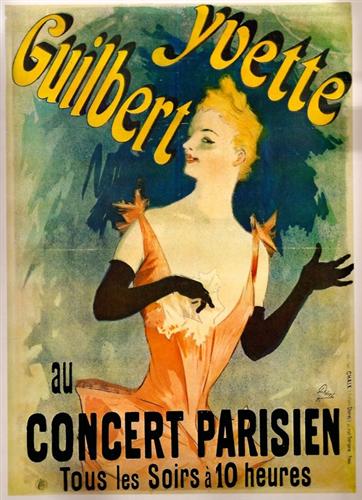On the Stage and On the Page: A Reflection of Celebrity Culture in the Yellow Book
Caitlyn Ng Man Chuen
Ryerson University
2376
A Love Often Duplicated

An advertisement showing Yvette Guilbert, 1891
Jules Cheret
|
In Stanley V. Makower’s
“On the Art of Yvette Guilbert”, much of the essay is used to discuss the
strong admiration that Makower has of Guilbert and her art form. Makower
writes, “[Guilbert’s individuality] is an individuality so marked, so rare,
that it almost constitutes by its own force a development by itself,
independent of a place in the history of its art, in the same way that the
strength of Chopin’s individuality makes it almost impossible to put him into
relation with other composers of music” (Makower 62). To say that Makower is a dedicated
fan of Guilbert is perhaps an understatement, as he talks about Guilbert’s art
with such intense and passionate language. However fervent Makower’s
appreciation for Guilbert is, his essay is not the only case in which Guilbert
is discussed with such favourable language to express admiration. In fact,
there are many essays and reviews written in the 1890s and afterward which
express a level of love for Guilbert similar to Makower’s. These writers often
speak of her “genius” (Cumberland 517) art, her “infinite charm” (Simpson 172),
and has been called “incomparable” (Jennings 574). To be frank, what Makower is
writing of is not anything that has not been said already and will continue to
be said about the talented Guilbert for the years following his essay’s publication
in the Yellow Book. Thus, although the Yellow Book seemed to draw many criticisms for being distasteful in its early years, “On the Art of Yvette Guilbert” is nothing revolutionary as the text falls in line with the writings of many of Makower’s contemporaries. Interestingly, Makower’s text is not even a review but simply an essay written in anticipation of Guilbert’s concert. This is not a reactionary text to some sort of event or news, but was written simply because Makower desired to write about it. There is nothing wrong with the text or Makower’s affinity for Guilbert, but the fact that the text was included in the Yellow Book, where the editors most likely sought out Makower as a contributor, is quite significant. While the Yellow Book is perhaps known for featuring works that present experimental art and ideas, “On the Art of Yvette Guilbert” reflects the opinions of the masses and subsequently is a text that would appeal to the masses. Thus, the inclusion of “On the Art of Yvette Guilbert” in the Yellow Book demonstrates that the magazine had a reflexive relationship to the popular culture of the era, despite its avant garde reputation. |

